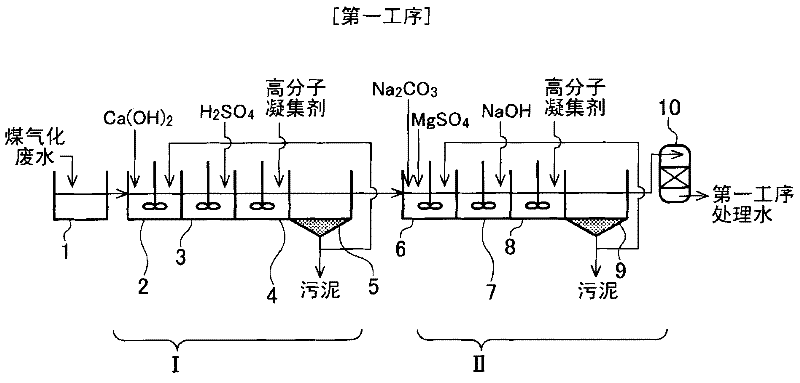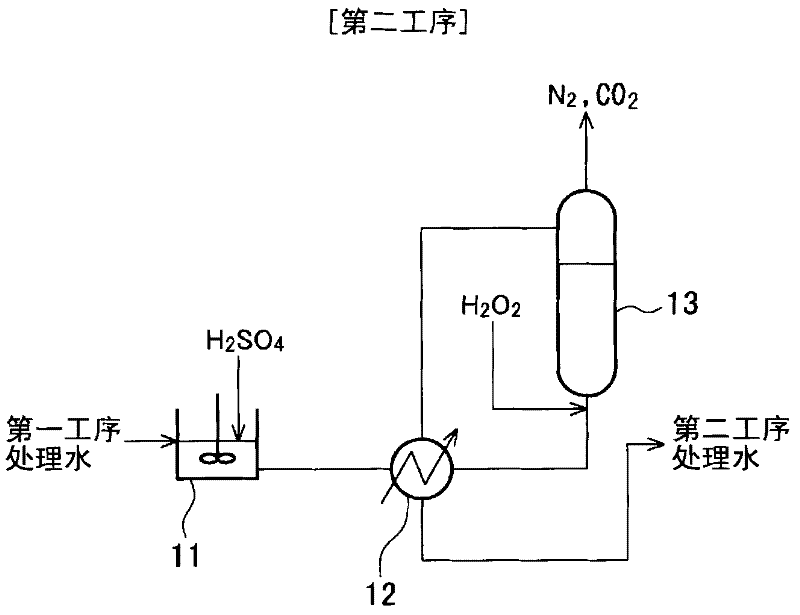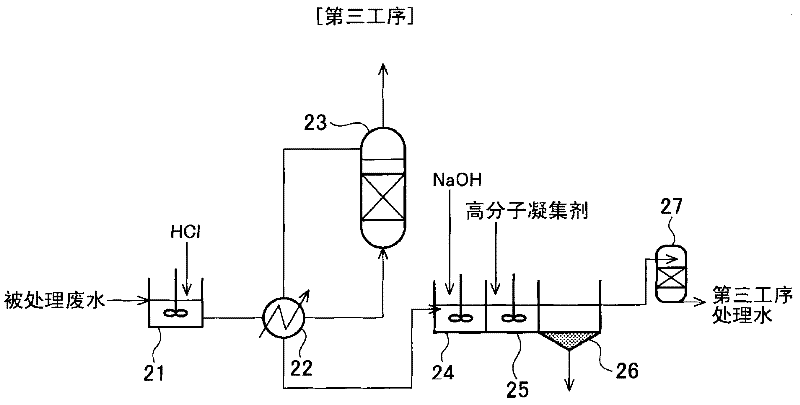Method of treating coal gasification wastewater
A technology of coal gasification wastewater and treatment method, which is applied in the fields of gaseous discharge wastewater treatment, degassed water/sewage treatment, oxidized water/sewage treatment, etc., and can solve the problem of not providing
- Summary
- Abstract
- Description
- Claims
- Application Information
AI Technical Summary
Benefits of technology
Problems solved by technology
Method used
Image
Examples
Embodiment 1
[0213] according to Figure 5 The treatment sequence shown is for the treatment of coal gasification wastewater.
[0214] The treatment conditions and the like in each step are as follows.
[0215] (Process (1): Coagulation and precipitation treatment of SS and fluorine)
[0216] according to the following conditions figure 1 Shown based on addition of Ca salt (using Ca(OH) 2 ) coagulation precipitation treatment and based on the addition of Mg salt (using MgSO 4 ) coagulation and precipitation treatment.
[0217] (Ca aggregation condition)
[0218] Ca addition amount = 2500mg / L (as Ca)
[0219] pH=7
[0220] Polymer coagulant: anionic polymer coagulant "Kurifarm PA893" manufactured by Kurita Kogyo Co., Ltd., with an addition amount of 3 mg / L.
[0221] (Mg aggregation condition)
[0222] (Implemented for supernatant water treated with Ca coagulation and precipitation)
[0223] Mg addition amount = 500mg / L (as Mg)
[0224] pH=11
[0225] Polymer coagulant: Kurifloc...
Embodiment 2
[0260] The treated water of the simulated process (2) prepared simulated wastewater with the following water quality, and carried out selenium treatment based on the Al / Ti method under the following conditions. Apart from image 3 This treatment was performed in the same manner except that aluminum and titanium were used as the metal reducing agent.
[0261] (raw water quality)
[0262] T-Se=5mg / L(Se(Ⅵ))
[0263] COD Mn =490mg / L (formic acid=4900mg / L)
[0264] NH 4 -N=4900mg / L
[0265] (based on reducing agent processing conditions)
[0266] Reductant: Al / Ti=1 / 1 (volume ratio)
[0267] Temperature: 65°C
[0268] Dissolution of Al: 1500mg / L
[0269] SV: 5 / hr (relative to Al)
[0270] (agglutination condition)
[0271] pH=7
[0272] Table 2 shows the processing results.
[0273] Table 2
[0274] project
[0275] As can be seen from Table 2, the selenium treatment by the Al / Ti method can sufficiently remove selenium as in the case of using an iron reducin...
Embodiment 3
[0277] according to Image 6 The treatment sequence shown is for the treatment of coal gasification wastewater.
[0278] In steps (1) to (4), the treatment conditions and treatment order of steps (1) to (3) are the same as those in Example 1.
[0279] Wherein, in step (2), H 2 o 2 The addition amount was set at 4000 mg / L, and the reaction time was set at 1 hr.
[0280] In addition, in the step (3), the amount of HCl added was set to be an amount such that the eluted iron amount became 1600 mg / L.
[0281] The treatment conditions of the step (4) are as follows.
[0282] (Process (4): ammonia stripping)
[0283] It implements with respect to the treated water of process (3).
[0284] NaOH was added to the wastewater to adjust the pH to 10, and then it was supplied from the upper part of a packed tower type diffuser filled with cascade ring packing, and steam and air were blown in from the lower part.
[0285] (air stripping conditions)
[0286] G / L=500 (air / wastewater vo...
PUM
 Login to View More
Login to View More Abstract
Description
Claims
Application Information
 Login to View More
Login to View More - R&D
- Intellectual Property
- Life Sciences
- Materials
- Tech Scout
- Unparalleled Data Quality
- Higher Quality Content
- 60% Fewer Hallucinations
Browse by: Latest US Patents, China's latest patents, Technical Efficacy Thesaurus, Application Domain, Technology Topic, Popular Technical Reports.
© 2025 PatSnap. All rights reserved.Legal|Privacy policy|Modern Slavery Act Transparency Statement|Sitemap|About US| Contact US: help@patsnap.com



